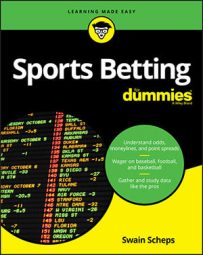 ©KAMONRAT/Shutterstock.com
©KAMONRAT/Shutterstock.comGame odds are a function of the oddsmaker and the bettors. The oddsmaker estimates a team’s chances of winning and sets the odds accordingly, with some adjustments for predictions of the public’s perception and perhaps an adjustment for park and weather effects. But then the odds are released into the wild. If bettors wager heavily on the favorite, their odds quickly get longer, and if bettors heavily bet the underdog, the odds go the other way.
Team streaks
Teams on win streaks tend to attract unearned attention from bettors. Remember the lesson of coin flips: Just because a coin has come up heads 5 times in a row, it doesn’t suddenly become more (or less!) likely to hit heads on the 6th flip. Sure, baseball teams aren’t coins. The trials aren’t independent because teams can get down on themselves or feel that they have a certain level of momentum.But there’s also a psychological effect at work on the betting side. If you bet against a team on a 10-game winning streak and lose, you’ll feel like the guy that does a faceplant into the plate glass window, thinking it’s a door. So, it’s not just a matter of bettors flocking to the streaking team; it’s also a matter of the normal attention you would expect the other side of the bet to receive starts to attenuate as the streak goes on. Add it all up, and you have potential for profit.
Bet against home teams on a moderate roll. History has shown a steady trend of +EV betting is available if you’re willing to bet against a home team on a winning streak. After 4 wins, the public seems to take note of the hot team and the over-betting begins.
Run line and moneyline bets against the streaky club have shown a positive ROI in the neighborhood of 5 to 10 percent. And there are several ways to make it more lucrative, such as finding the streaky team that’s a rare home underdog. This might happen if they’re up against the road team’s ace starter, for example.BET the win streak ends here
You should do your own exploration, but here’s the setup you’re looking for:During the MLB regular seasonA home team on exactly a 4-game win streak has offered contrarian bettors an overall 7-percent ROI on both the moneyline and run line bets. And the good news is that this scenario comes up about 100 times per year during the MLB regular season. In the data I looked at, if you blind bet this system, you would have made money in 8 of the last 10 years.The home team has won their last 4 games AND
The home team last lost 5 games ago
BET the visitor’s moneyline or the visitor’s run line.
The trend works on a 5-game win streak as well. If the home team has won exactly 5 games in a row, betting their opponent blindly would have yielded you 11 percent on the visitor’s moneyline and 6 percent on the run line.
Progressive Betting
You’ve probably heard of the Martingale or similar betting strategy where you bet 1 chip, and if you lose, you bet 2 chips. If you lose again, you bet 4 chips, and so on. In theory, you’re eventually going to win, so as long as you increase your subsequent bets by enough, you’re guaranteed to win. It might work in very short-term situations, but because casinos and bookmakers have betting limits, you quickly run out of real estate to increase your bet.The fact that baseball teams on win streaks are often over-bet makes it tempting to apply some sort of progressive multi-game betting strategy to the situation. For example, if you bet against the 4-in-a-row team and they win, you could double your bet and try betting against the same team again. In this scenario, your initial bet would lose a little over half the time. (Remember, you were betting on the underdog, so it’s ok to have a sub-50-percent winning percentage.) If you followed up that loss with a double-bet against that same streaking team, you’d end up with a positive ROI, even though it would be especially painful to lose two in a row.
In general, I don’t recommend progressive betting, but I have encountered handicappers and pickers who swear by multi-game betting systems like this. I suggest these precautions:
- Have a clear exit strategy; no open-ended systems. If your plan is to make increasing bets against a streaking team, set a maximum number of losses (how about 2?), at which point, you bail out.
- Make sure that the betting limits of your bookmaker are high enough relative to your bet amount so that you can easily increase your bet as needed.
More streak betting
What about a 6-game winning streak and higher? Here, the numbers aren’t so clear because the sample size dips to the point where the effect becomes harder to measure and more volatile. Betting against the home team on a 7-game streak was a money loser in 2019, but it only happened 6 times, so it’s hard to say if the system loses its potency or if there simply aren’t enough instances to take a good measurement.It’s possible that what we’re seeing is that bettors overvalue a team on a win streak by a certain standard amount, whether it’s a 4-game streak or a 10-game streak. But the team themselves doesn’t gain any kind of momentum edge until the win streak has gotten close to double digits. At that point, they really do have an edge in terms of confidence that raises their chances of winning beyond what the betting public sees. It’s possible, but I wouldn’t blame you for being skeptical of that rationale.
What about the other way? Do baseball bettors undervalue teams on a losing streak the same way they overvalue teams on a winning streak? The short answer is no. Unlike betting against teams on a win streak, betting for teams on a losing streak has not been lucrative. And it makes some sense when you consider the basic behavior of bettors: They bet for teams rather than against teams. Even though both insights are potentially profitable, bettors pay much closer attention to winning streaks than losing streaks, so the former get overvalued while the latter remain undistorted by the market.

